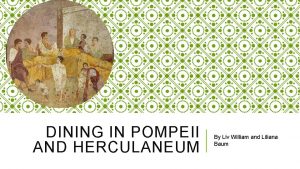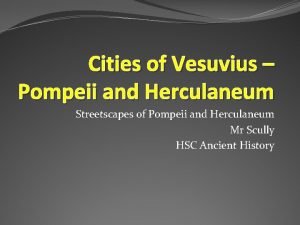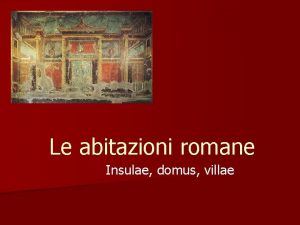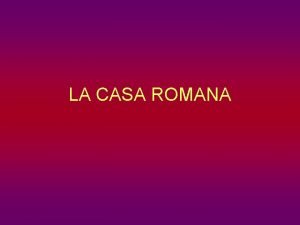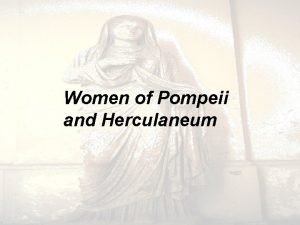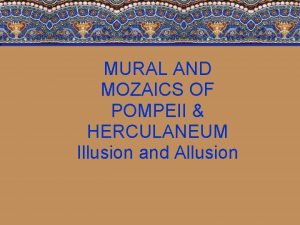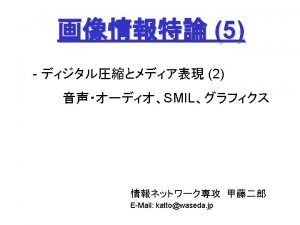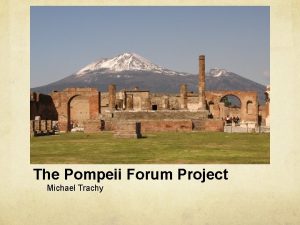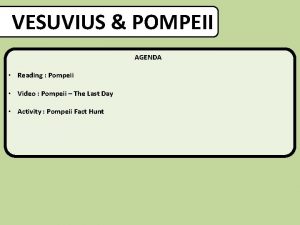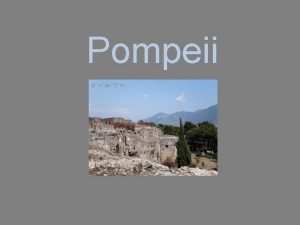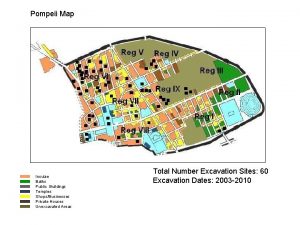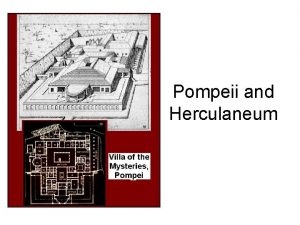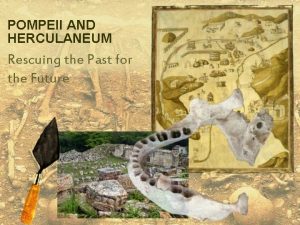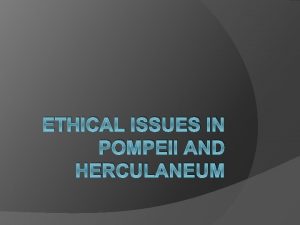The layout of Pompeii and Herculaneum Insulae Pompeii
















- Slides: 16

The layout of Pompeii and Herculaneum

Insulae Pompeii and Herculaneum consisted of rectangular residential blocks called insulae. These were separated by narrow streets which ran at right angles to the main, long, traffic thoroughfares. The house of the Surgeon, Insula I Region VI.

Insula walls Each insulae was bound by an outer wall. The walls of two insulae separated by a narrow street ( a cardo/ cardini), are shown in this image.

The walls of the insula buildings bordered the street and doors opened directly into the street. Fiorelli numbered the NINE regions of Pompeii and within each region he numbered up to 22 insulae. He also introduced the system of numbering the doors of the insula, so that a building could be identified by its region, its insula and its door number.

The majority of streets in Pomp and Herculaneum were narrow, about 2 -4 metres wide, although the major thoroughfares were up to seven metres wide.

Region 9

The distinct layout of Pompeii is evident in this image looking down the via di Mercurio. Each insula is bound by walls, with door openings into the streets. Within the walls are the houses, gardens, shops along the boundaries in commercial districts, and public buildings in some insulae. Pompeii was laid out on a grid pattern except for the earliest settlement. The main roads (decumani) are crossed by minor roads (cardini) enclosing the insulae. The main cardini are wide but most cardini are minor, narrow streets.

Typical insulae The plan at left is of a number of insulae in region 6 (vi) of Pompeii. A typical insula contained a number of buildings such as houses (some are shown in pink) , shops and public buildings. In the plan below from Region 1, a single house is indicated by the red.

Region 6 Insula 14

Insula I of region VI is bound by the wall of Pompeii, the Consolare Street which led to the Herculaneum gate, and Narcissus Street. Two of its houses are marked in colour – the House of the Vestals and the House of the Surgeon.

Region I Insula 9 Pompeii Area of focus for the British School of Archaeology. Insula 9, covering an area of 3000 square metres, comprises 8 discrete properties, formed of 13 separate units (including 5 dependent shops and workshops), made up of 116 rooms or separate spaces, totalling 560 wall and floor surfaces (source is British School of Archaeology web site).

HERCULANEUM Decumanus maximus Decumanus inferior Cardo 5 Cardo 4 Cardo 3

This street in Herculaneum shows the same layout of insulae bordering narrow streets. The streets are identified as decumani and cardini 7 The layout of Herculaneum is made of orderly rectangular blocks (called insulae. ). The town consisted of houses and shops packed tightly together. Because there were no backyards in Herculaneum, columns and walls created courtyards and gardens. 2 6 3 5 4



Know the essentials • • General grid layouts Decumani and cardini (decumanus, cardo) Insulae – description- thorough. Regions – an investigation system introduced by Fiorelli. How many regions in Pompeii – how many insulae per region? How much has not been excavated? • Herculaneum – how many insulae? Why a problem identifying extent?
 Food and dining in pompeii and herculaneum
Food and dining in pompeii and herculaneum Representations of pompeii and herculaneum over time
Representations of pompeii and herculaneum over time Streetscapes in herculaneum
Streetscapes in herculaneum Pompeii and herculaneum source booklet
Pompeii and herculaneum source booklet Pianta insula romana
Pianta insula romana Slidetodoc
Slidetodoc Paraganglia
Paraganglia Role of women in pompeii
Role of women in pompeii Herculaneum
Herculaneum Herculaneum baths
Herculaneum baths Herculaneum map
Herculaneum map Denominator layout
Denominator layout Language
Language Cddat
Cddat Fluid layout vs fixed layout
Fluid layout vs fixed layout Roman concrete
Roman concrete Pompeii forum reconstruction
Pompeii forum reconstruction
